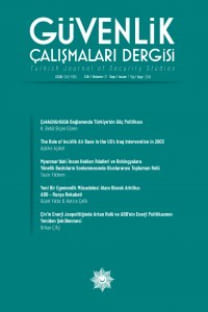Küresel Hukuki Boyutuyla Denizde Terörizm
Siyasi ve ideolojik amaçlarla bilinçli şiddet kullanarak korku yaymakla özdeşleşen terörizm, nadir de olsa denizler ve limanlardaki hedeflere yönelebilmektedir. Bu bağlamda sivil ya da savaş gemileri, petrol tankerleri, deniz altı kabloları, denizden geçen enerji boru hatları veya kıyı tesisleri hedef olabilmektedir. Ayrım gözetmeden hedeflere dönük saldırı, sabotaj, rehin alma, kaçırma gibi terör eylemleri, deniz üzerinden seyahat edenlere, deniz çevresine, küresel deniz ticaretinin akışına ve uluslararası deniz güvenliğine ciddi tehdittir. Çalışmada bu tehditlere karşı uluslararası topluluğun küresel güvenliği sağlamak adına şimdiye kadar yasal zeminde aldığı önlemlerin yeterliliği değerlendirilmektedir. Bu çalışmada denizde terörizm eylemleri geleneksel terörizmden siyasi ve ideolojik bağı koparılmadan; ancak aynı zamanda denizlerin kendine özgü koşullarına göre değerlendirildiği takdirde hukuki tedbirlerin küresel çapta etkili olacağı vurgulanmaktadır.
Anahtar Kelimeler:
Denizde Şiddet, Denizde Terörizm, Deniz Güvenliği, Küresel Güvenlik, Hukuki Kurallar, Maritime Terrorism with a Global Legal Dimension, Violence at Sea, Maritime Terrorism, Maritime Security, Global Security, Legal Rules
Maritime Terrorism with a Global Legal Dimension
Terrorism, identified with spreading fear by using deliberate violence for political and ideological purposes, rarely targets the seas and ports. In this context, civilian or warships, oil tankers, submarine cables, energy pipelines crossing the sea, or coastal facilities can be targeted. Such systematic and indiscriminate acts of terrorism severely threaten the marine environment, the flow of global maritime trade and international maritime security. In this study, it is emphasized that maritime terrorism will be effective worldwide if legal measures are evaluated according to the unique conditions of the seas without breaking its political and ideological ties with traditional terrorism.
Keywords:
Denizde Şiddet, Denizde Terörizm, Deniz Güvenliği, Küresel Güvenlik, Hukuki Kurallar, Violence at Sea, Maritime Terrorism, Maritime Security, Global Security, Legal Rules,
___
- Arifin, J. A. & Juned, M. (2023). Nigeria’s Compliance with the Yaoundé Code of Conduct in the Cases of Piracy and Armed Piracy of the Nigerian State in the Gulf of Guinea in 2016-2021, Journal of Social and Political Sciences, 6(1):110-120.
- Asal V. ve Hastngs J.V. (2015). When Terrorism Goes to Sea: Terrorist Organizations and the Move to Maritime Targets. Terrorism and Political Violence. 27 (4), ss. 722–740. https://doi.org/10.1080/09546553.2013.855636
- Bateman, S. (2006). Assessing the Threat of Maritime Terrorism: Issues for the Asia-Pacific Region. Security Challenges. 2 (3), ss. 77-91.
- Beckman, R. C. (2009). “The 1988 SUA Convention and 2005 SUA Protocol: Tools to Combat Piracy, Armed Robbery, and Maritime Terrorism”, Herbert-Burns, R., Bateman, S., & Lehr, P. (Eds.), Lloyd’s MIU Handbook of Maritime Security içinde (ss.187-200). London: CRC Press.
- Bowley, R. (2023). Preventing Terrorist Attacks at Sea: Maritime Terrorism Risk and International Law. London and New York: Routledge.
- Doorey, T.J (2016). Maritime Domain Awareness. Shemella, P., Global Responses to Maritime Violence: Cooperation and Collective Action, California: Stanford University Press. ss. 124-141.
- Farewell, R. (2007). Maritime Terrorism: Focusing on the Probable. Naval War College Review. 60 (3), ss. 46-60.
- Greenberg, M. D. & Chalk, P. & Willis, H. H.& Khilko, I., & Ortiz, D. S. (2006). Maritime Terrorism: Risk and Liability. Rand Corporation.
- Guide to Maritime Security & ISPS Code (2012). London: IMO Publication.
- Halberstam, M. (1988). Terrorism on the High Seas: The Achille Lauro, Piracy and the IMO Convention on Maritime Safety. The American Journal of International Law. 82 (2), ss. 269-310. https://doi.org/10.2307/2203189
- Hansen, H. T., (2009). Distinctions in the Finer Shades of Gray: The “Four Circles Model” for Maritime Security Threat Assessment. Herbert-Burns, R., Bateman, S., & Lehr, P. (Eds.), Lloyd’s MIU Handbook of Maritime Security içinde (ss. 73-83) London: CRC Press.
- Hong, N., ve Ng, A. K. (2010). The International Legal Instruments in Addressing Piracy and Maritime Terrorism: A Critical Review. Research in Transportation Economics. 27 (1), ss. 51-60. https://doi.org/10.1016/j.retrec.2009.12.007
- IMB ICC Piracy and Armed Robbery Against Ships Report (January-December 2022), https://www.icc-ccs.org/reports/2022%20Annual%20IMB%20Piracy%20and%20Armed%20Robbery%20Report.pdf (Erişim Tarihi:29 Mayıs 2023).
- Kızılsümer Özer, D. (2016). Uluslararası Hukuk ve Denizde Yasadışı Faaliyetlerin Önlenmesi. Dokuz Eylül Üniversitesi Hukuk Fakültesi Dergisi. 17 (2), ss. 27-62.
- Klein, N. (2011). Maritime Security and the Law of The Sea. Oxford University Press.
- Kozanhan, M. K. (2022). Deniz Emniyeti Kavramından Deniz Güvenliğine Geçiş ve 11 Eylül Sonrası Gelişmeler. Şahin, K. (Ed.), Deniz Hukuku ve Güvenliği içinde (ss. 63-87). Ankara: Seçkin Yayıncılık.
- Lehr, P. (2009). Maritime Terrorism: Locations, Actors, and Capabilities. Herbert-Burns, R., Bateman, S., & Lehr, P. (Eds.), Lloyd’s MIU Handbook of Maritime Security içinde (ss.55-71). London: CRC Press.
- Menzel, A. (2018). Institutional Adoption and Maritime Crime Governance: The Djibouti Code of Conduct, Journal Of The Indian Ocean Region, ss.1-18. https://doi.org/ 10.1080/19480881.2018.1467360
- Møller, B. (2009). Piracy, Maritime Terrorism and Naval Strategy. Danish Institute for International Studies Report. Copenhagen.
- Murphy, M.N. (2007). Contemporary Piracy and Maritime Terrorism: The Threat to International Security. London: Routledge.
- Murphy, M.N. (2008). Small Boats, Weak States, Dirty Money: Piracy & Maritime Terrorism in the Modern World. London: Hurst & Company.
- Murphy, M.N. (2009). Lifeline or Pipedream? Origins, Purposes, and Benefits of Automatic Identification System, Long-Range Identification and Tracking, and Maritime Domain Awareness. Herbert-Burns, R., Bateman, S., & Lehr, P. (Eds.), Lloyd’s MIU Handbook of Maritime Security içinde (ss. 13–28). London: CRC Press.
- Öktem, A. E. (2007). Terörizm: İnsancıl Hukuk ve İnsan Hakları. İstanbul: Derin Yayınları.
- Şahin, K. (2021). Küresel Deniz Güvenliğine Yönelik Hukuki Tedbirler: Uluslararası Denizcilik Örgütü Sözleşme, Karar, Protokol, Kod ve Uygulamaları. Elektronik Siyaset Bilimi Araştırmaları Dergisi. 12 (2), ss. 31-45.
- Tsamenyi, M. ve Palma, M. A. (2009). Long-Range Identification and Tracking Systems for Vessels:Legal and Technical Issues. Herbert-Burns, R., Bateman, S., & Lehr, P. (Eds.), Lloyd’s MIU Handbook of Maritime Security içinde (ss. 215-232) London: CRC Press. United Nations Convention on the Law of the Sea, (t.y.), https://www.un.org/depts/los/convention_agreements/texts/unclos/unclos_e.pdf (Erişim Tarihi:24 Mayıs 2023).
- ISSN: 2148-6166
- Başlangıç: 2000
- Yayıncı: Polis Akademisi Başkanlığı
Sayıdaki Diğer Makaleler
Küresel Hukuki Boyutuyla Denizde Terörizm
Yapısal Şiddet Bağlamında Başarısız Devletler ve Terörizm İlişkisi: Yemen ve Suriye Örnekleri
Sınır Güvenliği Paradigmalarının Değişimi Ekseninde Türkiye’nin Sınır Güvenliği
Kuruluşundan Bugüne Lübnan Hizbullah’ı: Lübnan’a Verdikleri ve Lübnan’dan Aldıkları
